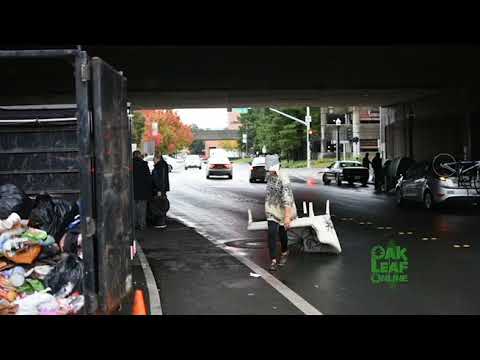Santa Rosa Police ordered the homeless people living in encampments beneath the Highway 101 overpass along Fifth, Sixth and Ninth Streets to vacate by noon on Nov. 15.
Police threatened to issue citations and arrest those who failed to comply on misdemeanor charges carrying the possibility of a six-month jail sentence. Police warned occupants of the eviction at 6 a.m. Nov. 14, but many residents scrambled to gather belongings from tents and shopping carts 36 hours later.
“The camp is spread to where it’s blocking parking and parts of the sidewalk,” said Santa Rosa Police Sergeant John Wolf.
Members from the Community Action Coalition, Homeless Services Outreach and Police Brutality Coalition arrived to assist those forced to vacate, offering transportation to nearby shelters and lending a helping hand in gathering belongings.
“We’re out here to help,” said a community activist who goes by the name of Merlin. “We’re collecting evidence to be used in people’s defense. Some of us are working on an injunction and others are working on a temporary restraining order against the city,” Merlin said.
The police department is working in collaboration with HOST (Homeless Outreach Services Team), operated by Catholic charities and funded by the city of Santa Rosa. The city has undertaken a homeless encampment cleanup pilot program to address the health, safety and shelter of homeless persons living in encampments around the city.
The top three priority encampments identified by the homeless encampment pilot program are: Homeless Hill in Bennett Valley, the encampments located at the downtown underpasses and the encampment at Bicentennial Way.
The encampments at the underpass not only disrupt the public, they disrupt nearby businesses with the health and safety risks.
“People around the area are obviously concerned with the recent hepatitis a outbreaks in Santa Cruz and San Diego,” Sergeant Wolf said. “We’ve found human waste on the sidewalks, that’s exactly how hepatitis a is spread.”
Sergeant Wolf also pointed out that there are two 24-hour porta-potties open to the public less than a block away from the encampments.
The recent North Bay wildfires, coupled with the long-standing housing shortage in Sonoma County, have severely limited long-term housing solutions and access to quality resources for the city’s homeless population. The apparent lack of a viable solution has pitted the city and its homeless population in a tense standoff.
“It’s a little late to be optimistic for the police to say, ‘we’re not going to commit a human atrocity’,” Merlin said. “Once the fires happened, the size of this encampment expanded rapidly.”
A majority of residents living at the encampments were previously vacated from homeless encampments in Santa Rosa’s Montgomery Village neighborhood. “Remembrance Village” located behind the Dollar Tree store on Sebastopol Road in Santa Rosa, stands as one of the only options left for those with no place to go.
The cycle of evicting one homeless camp after another has rendered shelters as an inadequate solution, unable to provide enough beds for the more than 100 residents living in the encampments. However, the idea of shelters doesn’t appeal to all homeless people living at the encampments.
“There were fewer people interested in being taken to shelters then there were beds for shelters,” Sergeant Wolf said.
“I really hope some of these people go to Remembrance Village and find shelter there. It’s better than staying here and running the risk of getting arrested and losing everything,” Merlin said.
“The city should expand the camp behind the Dollar Tree and let us all go there,” said Kelie Jones, 40, a homeless woman at the Sixth Street encampment. “They make it nearly impossible for us. All I have to put my stuff in is a shopping cart and the police told me that was illegal.”
Although it may not look like it to some, the city has made some headway in lowering the population of homeless. “1,900 homeless persons in Santa Rosa is lower than what’s it been in the past five to ten years,” Sergeant Wolf said.
The declining number of homeless is harder to see for the public. The SMART train removed a number of homeless encampments located near train tracks and out of the public eye, causing these homeless populations to relocate within the city and closer to public property and businesses.
While answers to the wide-ranging housing crisis and the homeless population remain fleeting at best, prospects for Sonoma County’s homeless population continue to dwindle.
One resident at the homeless encampment offered up a small suggestion to the giant problem, “The city should give us lockers. Lockers would make having to be homeless so much easier.”
Additional reporting by Brandon McCapes.
Video by Brandon McCapes, James Wyatt and Michael Barnes
An earlier version of this article mentioned an encampment under Seventh Street, although Seventh Street does not continue under the overpass. This version changed Seventh to Ninth Street.







Courtney • Dec 26, 2017 at 9:57 am
Prioritize the voices of those who are homeless next time. Also the housing first pilot program is systematically raiding homless encampments and are providing little to no services and pushing them into roseland. Away from white biz owners and white wealth.
Carolyn Lewis • Nov 15, 2017 at 11:54 pm
Thank you for your reporting today and nice to meet you.
Gregory C. Fearon • Nov 15, 2017 at 11:45 pm
Thanks for the excellent coverage.
Gregory Fearon. Homeless Action